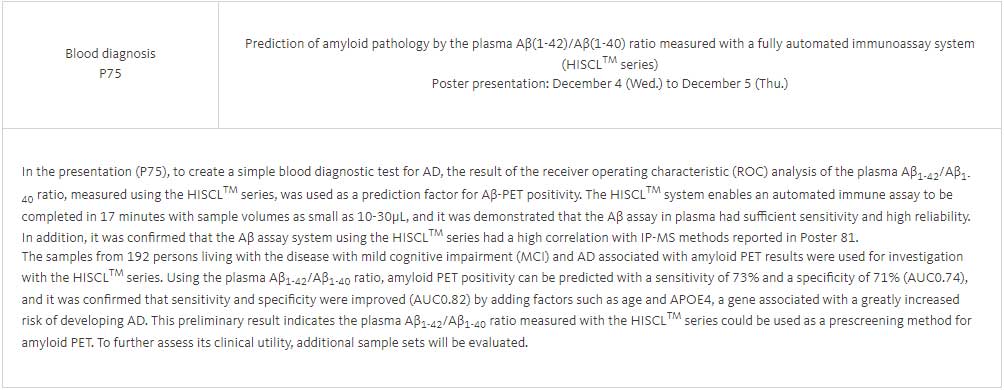Company News
Sysmex presents report about diagnosing Alzheimer’s disease using blood
Sysmex Corporation and Eisai Co., Ltd. are pursuing a joint project to develop a method of diagnosing Alzheimer’s disease (AD) using blood, presented two posters showing the most recent data from the project. The presentations took place at the 12th Clinical Trials on Alzheimer’s Disease (CTAD) conference, from December 4 to 7, 2019, in San Diego, California. At CTAD, Sysmex demonstrated on behalf of the two companies the possibility of understanding amyloid pathology in the brain from the brain-derived amyloid beta (Aβ) in plasma measured using its protein measurement platform, the HISCL™ series of fully automated immunoassay analyzers.
The total number of those living with dementia across the world is projected to reach 82 million in 2030 and 152 million in 2050, with the total global societal cost of dementia stemming from direct medical and social care costs and lower productivity being estimated to reach 220 trillion yen in 2030. In Japan, the number of those with dementia is thought to have reached approximately 4.62 million in 2012 and is projected to grow to 7.30 million in 2025, with the total societal cost of this disease being estimated to be equivalent to 4.1% of the gross domestic product (GDP) in 2025 (25.8 trillion yen). Of these sufferers, those living with AD is thought to account for more than 60% of those living with dementia.
It is conceivable that AD is a disease that results in synaptic dysfunction and neuronal cell death due to the tau deposition in neurons triggered by Aβ aggregation on the outside of neurons. These brain changes cause the cognitive impairment and psychological and behavioral symptoms, suggesting that the Aβ aggregation and accumulation inside the brain is caused by AD before the presence of cognitive impairment appears, thus, it is believed that early diagnosis and early intervention is more effective in therapies targeting Aβ. Currently, amyloid PET and the plasma Aβ1-42/Aβ1-40 ratio in cerebrospinal fluid (CSF) are used for detecting amyloid aggregates in the brain, but this puts significant burden on patients in terms of access, costs, and their physical wellbeing.
In February 2016, Sysmex and Eisai signed a comprehensive non-exclusive agreement aimed at the development of new diagnostic tests in the field of dementia. By leveraging each other’s technologies and knowledge, the objective has been to discover next-generation diagnostic reagents that will enable early diagnosis of dementia, selection of the most appropriate treatment options, and regular monitoring of the effects of such treatments.
At the Alzheimer’s Association International Conference (AAIC) held in July 2019, Sysmex and Eisai presented their joint research on the correlation (Spearman’s rank correlation coefficient (rs)=0.502, p<0.001) between the Aβ1-42/Aβ1-40 ratio in CSF and the Aβ1-42/Aβ1-40 ratio in plasma, and demonstrated that it may be possible to understand amyloid pathology in the brain by measuring the plasma Aβ1-42/Aβ1-40 ratio. Subsequently, the two companies have examined the correlation between the plasma Aβ1-42/Aβ1-40 ratio and amyloid PET.
Sysmex and Eisai are engaged in joint development aimed at creating a simple method of diagnosing AD from a blood sample. At CTAD, Sysmex demonstrated that it may be possible to understand pathological processes in the brain by measuring the plasma Aβ1-42/Aβ1-40 ratio based on the analysis result of the plasma Aβ1-42/Aβ1-40 ratio measured with the HISCLTM series as a prediction factor for Aβ PET positivity. Also it was presented a technique for verifying that the HISCLTM measuring system correctly captures Aβ in plasma on that occasion.
Sysmex and Eisai are working to create new diagnostic technologies for the prevention and treatment of dementia. Accordingly, the overarching aim is to contribute to the advancement of healthcare and improve the quality of life for those living with the disease and their families.
Data sheet


MB Bureau












